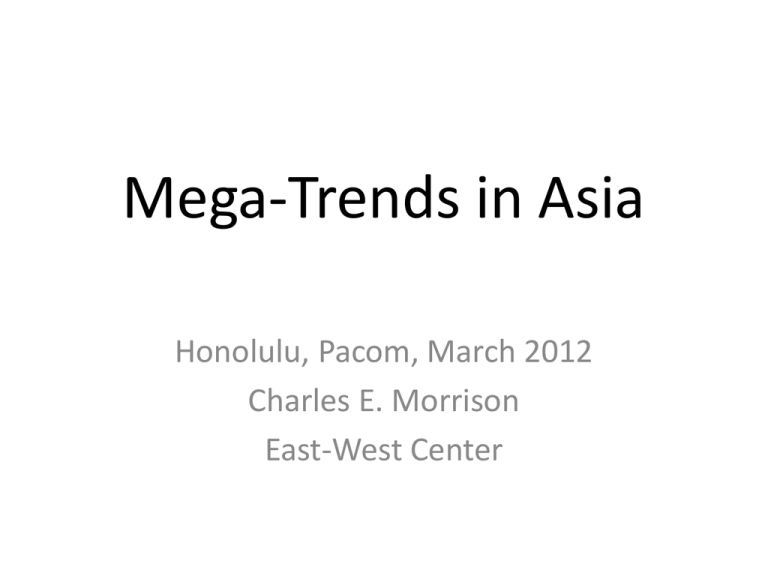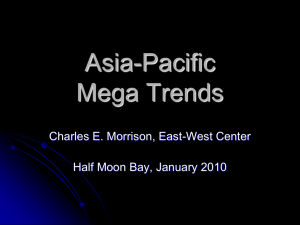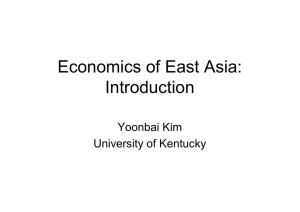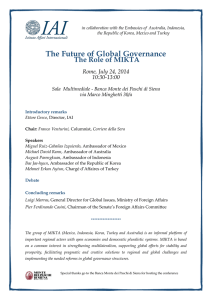Critical Issues in Asia-Pacific
advertisement

Mega-Trends in Asia Honolulu, Pacom, March 2012 Charles E. Morrison East-West Center Connecting Dots: Three Mega-Disasters • December 2004: Indian Ocean Earthquake and Tsunami: 230,000 dead • October 2005: Kashmir Earthquake: 80,000 dead • May 2008: Sichuan Earthquake: 70,000 dead Tectonic Plates in Southern Asia Kashmir EURASIA PLATE Kathmandu Chengdu INDIA PLATE Aceh Change Certainties/Uncertainties Near Certainties: Uncertainties: • The “rise” of Asia • Demographic changes • Pressures on resources and the environment • New health challenges • Sustainable development? • Social and political evolution • International relations • Asia-Pacific role in addressing global issues Rise/Re-rise of Asia: Asia’s Share of World Gross Product Over 200+ Years 60 50 ?? 40 30 20 10 0 1820 1870 1913 1950 1970 1990 2010 2050 from “World Population, GDP and Per Capita GDP, 1-2006 A.D.,” HDerived by Angus Maddison; Asia includes South Asia Growth of Tertiary Enrollment (Enrollment Ratios, 1985-2007) Source: World Bank USA Korea Japan Thailand Philippines Malaysia China Indonesia India 100 90 80 70 60 50 40 30 20 10 0 Education: Percent by Gender of Tertiary Age Population in Tertiary Institutions, 2008 70 60 50 40 30 20 10 0 India Indonesia China Philippines Female Hong Kong Thailand Male Source: UNESCO Institute of Statistics (India and Hong Kong, 2007) Japan Intra-Regional Trade Integration 70 European Union – 25 60 Integrating Asian Economies 50 NAFTA 40 30 20 10 0 1955 1965 1975 1985 Source: Peter Petri, East-West Center 1995 2005 Demographic Tectonics China’s Population in Comparative Perspective Fertility Decline Total Fertility Rate: Babies per Female 7 6 5 1950 1975 2000 2025 2050 4 3 2 1 0 East Asia Southeast Asia South & Central Asia East-West Center, The Future of Population in Asia, 2002, p. 10. Asia Population People (millions) 3000 2500 East Asia 2000 S.E. Asia 1500 South and Central Asia 1000 500 0 1950 1975 2000 2025 2050 Year East-West Center, Future of Population “Flight from Marriage:” (Never Married Rates: Female, Age 35-39) 14 25 12 20 10 15 8 6 10 4 5 2 0 1970 0 1970 1990 Indonesia Thailand 1990 2000 2000 S. Korea Japan Jakarta Hong Kong Seoul Bangkok Adapted from Gavin C. Jones, The “Flight from Marriage” in South-East and East Asia Composition of Population (Japan) Share of Young Adult Population in East Asia (Ages 15-24) 25 20 15 10 5 0 1960 1980 1985 1990 2000 2020 2040 Source: Graeme Hugo, University of Adelaide, based on United Nations 2003, excludes Western Asia Growth of Elderly Percent of Population Over Age 75 • India Indonesia Vietnam Thailand 2000 China 2050 S. Korea Singapore Japan 0 5 10 15 20 Source: East-West Center, Future of Population, 2002 25 East Asian Urban Agglomerations (Megacities) over 10 million 1950 2008 estimates Tokyo, 11.3 million Tokyo, 34.4 million Jakarta, 21.8 million Seoul-Inchon, 20.0 million Manila, 19.6 million Osaka, 17.3 million Shanghai, 14.5 million Beijing, 12.8 million Guangzhou, 11.8 million Shenzhen, 11.7 million Bangkok, 10.8 million 1975 Tokyo, 26.3 million Osaka, 14.0 million Seoul-Inchon, 12.0 million Shanghai, 11.4 million Wikipedia Sources, figures vary Comparative GDP, 2008 (PPP estimates) • • • • • • • • Tokyo, $1,479 billion South Korea, $1,342 billion Canada, $1,303 billion Australia, $795 billion Philippines, $320 billion Hong Kong, $307 billion Seoul, $291 billion Vietnam, $240 billion Source: Cities, Pricewaterhousecoopers. Countries, IMF Asia Pacific Disaster Map with Mega-cities Beijing Tokyo yo Shanghai Osaka Manila Kolkata Jakarta Source: Pacific Disaster Center Resource Pressures Regional Petroleum Deficits Millions of Barrels per day 30 25 20 Europe N. America Asia-Pacific 15 10 5 0 1973 2001 Congressional Research Service 2020 est. AUTOMOBILES (Millions) Other Africa South Africa Other LA Brazil Middle East India Other Asia China Eastern Europe Asian TE Russia Korea Japan Australia and NZ Other OECD Europe UK Italy Germany France USA Mexico Canada 3,500 3,000 2,500 India 2,000 Other Asia 1,500 China 1,000 500 0 1975 1985 1995 2005 2015 2025 2035 2000 International Energy Agency Projections 2045 2050 China’s, India’s, Share of World. . . • Population: 20.1, 18.0 percent • Coal Reserves: 12.6, 10.2 percent • Oil Reserves: 1.3, 0.5 percent • Natural Gas Reserves: 1.3, 0.6 percent Source: East-West Center, The Future of Energy in Asia-Pacific, 2007 Fresh Water (Per Capita) Sources: Earthlab, UN Environment Program Eart Northern China Has . . . • 65 percent of China’s arable land • 47 percent of its population • 43 percent of GDP And only . . . • 19 percent of China’s water resources Source: Christine E. Boyle Water Problem: A Chinese Perspective China Daily cartoon, 14 November 2006 Growth of Per Capita Meat Consumption – China, 1980-2007 54 kg 60 50 40 30 20 kg 20 10 0 1980 2007 Source: Jonathan Watts, The Guardian, 30 May 2008 Note: For comparison, US per capita consumption about 122 kg Health Tectonics • Traditional Health Risks (down) • New infectious diseases, including HIV/AIDS, avian flu, new strains of tuberculosis (careful monitoring required) • Chronic conditions and diseases associated with aging and life style changes (up) Infectious Diseases: A Health Fault Line? • • • • • “Spanish Flu” Pneumonia: 1919 Asian Flu: 1967 “Bird” Flu (Hong Kong): 1997 SARS: 2003 “Avian” Flu: 2004- Poultry Density Source: FAO, AGA Livestock Atlas Series 11-Year-Old Children’s Fitness Japan Average Soft-Ball Throw (Meters) Seconds to Run 50 Meters 9.4 Boys Girls 9.2 9 35 30 8.8 25 8.6 8.4 20 8.2 1987 2006 15 1987 2006 Source: Japan Ministry of Education, Science and Technology, 2007 Obesity in South Korea 35 30 25 20 1997** 2007 15 10 5 0 Children* Adults Korea National Health and Nutrition Survey for 2007 as reported in Chosun Ilbo, November 17, 2009. * Age 2 to 18. ** 1998 for adults. Prevalence of Diabetes: 2000-2030 80 151% increase 70 148% increase 60 50 104% Millions 40 people 30 2000 2030 20 10 0 India China Other Asia Source: Wild, S, Roglic G., Green, A., Sicree, R, and King, H. “Global Prevalence of Diabetes: Estimates for the Year 2000 and Projects for 2030, Diabetes Care, Vol. 27, Number 5, May 2004. Average global increase 114%. Suicide Rates 1 Suicide Rates 2: Case of Korea The Uncertainties • Sustainable development - Economic models - Resource impacts • Domestic evolution - Social disparities - Political dynamics • International relations • Global leadership Gini Co-efficients 0.7 Brazil 0.6 Mexico 0.5 China Brazil Mexico USA China Japan USA 0.4 Japan 0.3 0.2 0.1 0 1980 1985 1990 1995 2000 2005 2007 Sources: World Bank, Chinese Academy of Social Sciences One of the big drivers of change… now China and India are getting serious Global Carbon Emissions Map from The Guardian Datablog CO2 Emitters Per Capita (tons) 25 20 15 10 5 0 US Canada Australia Japan China India Attitude Survey on Environment Who Hurts the Environment the Most? China % Americans 40 Chinese 9 Japanese 67 Koreans 64 Indonesians 11 Germans 39 Pew Global Attitude Project, 2008 US % 22 26 17 19 42 34 Governance Issues and Political Transitions Political Systems in Evolution • Recent coups or attempted coups in recent years: Philippines, Timor Leste, Fiji, Bangladesh • New democracy: Indonesia • Maturing democracies: South Korea, Taiwan • Frequent leadership changes: Japan, Thailand, Nepal • Socialist countries in transition: China, Vietnam • Autocratic regimes: North Korea, Burma Some Geo-Political Issues • Last International War? • Ethno-nationalism (internal/international dimensions) - Pacific/Atlantic difference • Power Transitions • “Afpak” • Future of Cross-Strait Relations • Future of the Korean Peninsula • Territorial Disputes • Regional Architecture, including alliance systems, multilateral organizations (APEC, AES) THANK YOU THANK YOU SkyStudio Hawaii











